#kanban template
Explore tagged Tumblr posts
Text
Kanban Template Essentials: Streamline Your Workflow

A template of Kanban is a visual representation of a Kanban board, a powerful tool used in agile project management to optimize workflow and enhance team collaboration. The template typically consists of columns and cards that represent different stages of work, from initial tasks to completion. Each card on the Kanban board represents a specific task or work item, allowing team members to visualize the status of each item at a glance.
The primary purpose of a Kanban template is to facilitate efficient task management and workflow visualization. By organizing tasks into columns such as "To Do," "In Progress," and "Done," teams can track progress in real-time, identify bottlenecks, and prioritize tasks accordingly. The visual nature of these templates promotes transparency and clarity within the team, ensuring everyone is aligned on the current status of projects and tasks.
Moreover, they are highly adaptable and can be customized to suit the specific needs and processes of different teams and projects. Teams can add additional columns, labels, or swimlanes to the Kanban board as needed, allowing for flexibility in managing different types of work or projects with varying complexities.
Kanban Cards Examples
Kanban cards serve as visual representations of tasks or work items on a Kanban board. Examples include cards labeled with specific tasks such as "Develop Feature A," "Review Design Mockups," or "Test Software Update."
Each card typically contains key details like task description, assigned team member, due date, and current status. These cards move across the Kanban board columns (e.g., To Do, In Progress, Done) as work progresses, providing a clear visual indication of task status and workflow.
Kanban Board Example
A typical Kanban board example consists of columns representing different stages of work, such as "Backlog," "To Do," "In Progress," and "Done." For instance, the "Backlog" column holds tasks waiting to be prioritized, while "To Do" lists tasks ready for action.
As work advances, cards move across columns from left to right, signaling progress. Each card on the board represents a specific task or project, detailing its status, priority, and responsible team member. This visual layout promotes transparency, improves workflow visibility, and aids in identifying bottlenecks or areas needing attention in agile project management.
Project Management Tools

Project management tools encompass a variety of software and applications designed to facilitate planning, organizing, and executing projects effectively. These tools typically offer features such as task management, scheduling, collaboration, resource allocation, and reporting. Popular project management tools include:
Trello: Known for its Kanban-style boards, Trello allows teams to organize tasks into customizable lists and cards, making it easy to track progress and collaborate. Also, it will show the productivity report perfectly.
Asana: Asana offers a versatile platform for managing tasks, projects, and workflows. It includes features like task assignments, due dates, timelines, and project portfolios.
Jira: Widely used in software development, Jira provides robust project tracking, issue management, and agile project management capabilities through customizable workflows and scrum boards.
Microsoft Project: A comprehensive tool for planning, scheduling, and managing projects, Microsoft Project offers Gantt charts, resource management, and reporting capabilities.
Why Does Project Management Software Worth It?
Project management software is invaluable because it centralizes and streamlines project-related activities, enhancing collaboration, efficiency, and overall project success. By providing tools for task management, scheduling, resource allocation, and communication, these platforms ensure that teams stay organized and focused on achieving project milestones. Users will analyze the weekly activity report easily.
Real-time updates and visibility into project progress enable stakeholders to make informed decisions promptly, while features like reporting and analytics offer insights for continuous improvement. Moreover, project management software fosters accountability among team members and improves workflow transparency, ultimately optimizing productivity and ensuring projects are completed on time and within budget. The investment in such software pays off by reducing risks, minimizing errors, and empowering teams to deliver high-quality results consistently.
Also Watch: Leading Employee Engagement and Workforce Productivity Tool
youtube
Final Words!
In conclusion, implementing a Kanban template is a strategic choice for enhancing organizational efficiency and workflow management. By visually mapping tasks across stages like "To Do," "In Progress," and "Done," templates provide clarity and transparency, enabling teams to prioritize effectively and track progress effortlessly.
This method not only streamlines project management but also fosters collaboration and improves responsiveness to changing priorities. Whether used in software development, marketing campaigns, or daily task management, a well-designed Kanban template promotes agility and continuous improvement, empowering teams to achieve their goals with greater efficiency and clarity. Embracing Kanban templates is a step towards optimizing processes and achieving sustainable success in dynamic work environments.
#kanban template#kanban cards examples#kanban board example#project management software#kanban#Youtube
0 notes
Text
Exploring the Benefits of Kanban Board Example
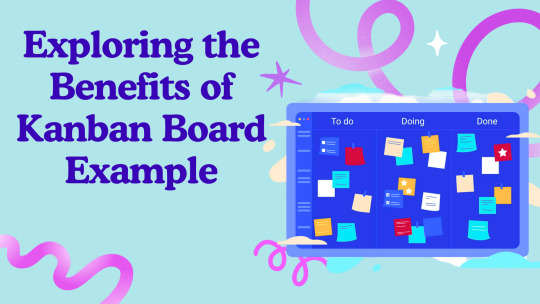
Imagine entering a room where each task, deadline, and project is arranged neatly before you. There would be no chaos or confusion, just a smooth workflow. No, this is not a dream factory. A Kanban board really can help your team.
In a world where efficiency is king and time is money, Kanban boards are becoming a powerful visual tool to transform messy work into organized work. By exploring the benefits of a Kanban board example, you'll find how this simple yet effective approach may help you to transform your productivity, enhance cooperation, and achieve your goals more quickly.
Whether you're new to Kanban or a seasoned pro, Delving deeper into these examples will provide new insights and inspiration to take your project management to the next level.
What is the Kanban Board?
Before getting into the benefits, you should first grasp what a Kanban board is. A Kanban board is a visual project management tool that aims to increase workflow efficiency and transparency. It uses columns to represent different stages of a process and cards to symbolize individual tasks. As tasks progress, they move across the board from one column to the next, providing a clear, real-time overview of their status. This visual technique assists teams in better managing their workload, identifying bottlenecks, and systematically completing tasks.
The Benefits of Project Management Kanban Board
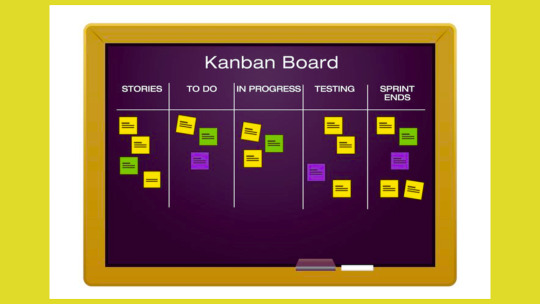
The benefits of Kanban board go beyond simple task management—they offer a clear path to optimizing your team’s processes and improving overall efficiency.
Enhanced Visibility and Transparency
One of the main benefits of using a Kanban board is its ability to increase visibility. By visualizing the entire workflow in a single dashboard, everyone on the team can see the status of their work at a glance. This transparency promotes better communication and keeps all team members informed of the current workload and progress of the project.
Improved Workflow Efficiency
Kanban boards help teams identify bottlenecks and inefficiencies in their processes. By limiting work in progress (WIP) and supporting pull-based systems, teams can avoid overloading members with too many tasks at a time. Kanban examples show how this leads to a smoother workflow, faster task completion, and a more balanced workload for the team.
Flexibility and Adaptability
Kanban boards are flexible and can be customized to suit any team or project. Kanban boards can be changed to meet your specific needs, whether you want to add a new column, change the work label, or color code by priority. Examples from different industries highlight how adaptable Kanban is, making it useful for software development, marketing, and beyond.
Continuous Improvement
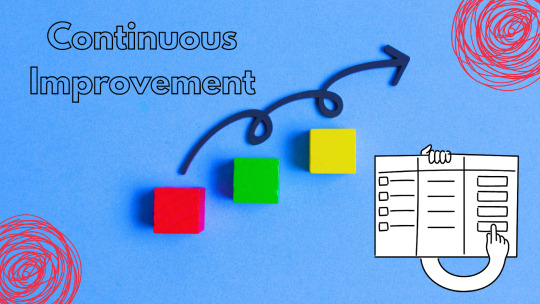
Kanban boards promote a culture of continuous improvement. Regularly reviewing workflows allows teams to make additional changes to increase productivity. An example Kanban board demonstrates how metrics such as cycle time may help teams make data-driven decisions and continuously improve processes for better results.
Exploring Kanban card examples can encourage teams to make use of these benefits. Increase teamwork, efficiency, and project results.
Kanban Card Examples
Kanban cards are an essential component of a Kanban board. They represent each task or work item in a project.
Task Name: "Design homepage layout"
Details: Design the layout for the new website homepage using wireframes.
Assigned To: Sarah
Due Date: Sept 15, 2024
Status: In Progress
Task Name: "Write a blog post"
Details: Write a 1,000-word article on remote work trends.
Assigned To: John
Due Date: Sept 12, 2024
Status: To Do
Task Name: "Customer feedback review"
Details: Review feedback from the latest product launch survey.
Assigned To: Emma
Due Date: Sept 20, 2024
Status: Done
Checkout this Video - EmpMonitor: Skyrocket Your Sales with Better Project Management
youtube
Summary
Finally, exploring the benefits of project management Kanban board illustrates how this basic yet effective tool may change the way teams organize their work. By enhancing visibility and transparency, improving workflow efficiency, and fostering continuous improvement, Kanban boards provide a clear framework for achieving better productivity and collaboration. Their scalability and flexibility make them suited for a wide range of businesses, while the visual approach keeps teams organized and motivated.
0 notes
Text


✂ atlas notion template.
Links: install (free) | more notion templates
Atlas is a free all-in-one tasks + notes + scheduler Notion Template, maximised in its design for daily use and organisation. Tasks views are available and synced across a neat list format, status-based kanban board, and weekly/monthly planner; view all your tasks and assign them at a glance.
This template comes in two versions: the standard version with database automations which require a Notion Plus plan or above, and a lite version for Notion Free plan users.
Features: synced notes database with neat list/table/kanban board/calendar views, track due dates + assign tasks to dates + records when task is done, weekly planner, notebook database, meeting minutes template, link notes to tasks
#this is actually what i currently use for my daily life so hopefully this helps yall too!#also most definitely my last release for the year#and perhaps my last notion template for awhile#back to tumblr codes i go#notion#notion templates by xue#notion templates#free notion templates
90 notes
·
View notes
Text
How I Stay Organized




Task Management
Task application in Microsoft Teams
Keep track of important emails by flagging the email in outlook and using tasks in team to keep up with sub tasks and important notes
Also one off items I need to keep track of
Kanban
Create templates for routine processes
It helps to ensure I am completing all the steps without having to remember them.
Helps with visualizing my tasks
Inbox Zero!!
Used to ensure my inbox is not insane and ensure I am resolving emails
I have folders pertains to routine tasks
A monthly Folder to archive misc items that do not fall into a specific category
Color coding my Outlook calendar
Pink = In person meetings
Green = Audit
Yellow = Walkthrough
Orange = Important Meetings but are virtual
Purple = Team meetings
Physical Planner
Catch all for important dates and deadlines. Personal and work related
Has a spread for monthly intentions, goals and bills due
Weekly review
Clear out my inbox
Look at Calendar for the upcoming week
Ensure all tasks are logged in teams
Clean out folders on desktop and get rid of files I no longer need, place items in the correct folders
Clean up inbox in OneNote
#feminine energy#leveled up mindset#luxury black women#black femininity#self improvement#it girl#that girl#black luxury#organization#improve productivity#productivity#corporate life
96 notes
·
View notes
Text
Novel Planning/Writing Programs/Sites
I wrote this mostly for myself as I've used many different things over the years with varying success, but I think it might be useful for others as well. Not sponsored. All below the cut. If you want the TLDR, scroll to the very bottom.
1. Google Docs
Free. Just regular ol' Google Docs for writing and organizing. If you lose a Doc, you can contact Google and they're pretty prompt about getting it back for you if you accidentally delete something and then empty your trash.
For writing, it helps to get one folder and then have a bunch of folders inside that folder for drafts. It also helps to make one Doc that's just for background information you might need or for outlining. For this, I've just made tables or used Google's built-in outlines. However, this is the model of an eleven year old and it can get pretty messy trying to keep track of too much.
2. Airtable
Free with paid version available. Not for writing, but good for organizing. There's a novel template as well. I like that you can link records together. I've been using it for awhile for things like species, scenes, locations, etc.
For family trees, I recommend changing the view from "Grid view" to "Kanban" and categorizing it by "Generation" (Gen 1, etc). This works really well for planning things out and world building in general. You can add images really easily as well. It's very user intuitive and I recommend playing around with categories and fields until you get it to your liking. Btw, if you sign up with the above link I get referral credit on the site! I'd appreciate it if this post proves helpful.
3. Notebook.ai
Free with paid version available. This is one of those programs that's technically free, but you need to pay for it to be really usable in some respects. I really like how it organizes characters and asks you questions that prompt you to think more about your character. Same with locations. So it's great for characters and locations, but not for stuff like species or races. If you want to write fantasy, I would not use this alone (but I would take a look to see if any of the questions help you with world-building or characterization). I'd use it in conjunction with something like Airtable.
4. novelWriter
Free. This offline software is great for novel-writing! You can move chapters around which is nice. It has all your work in this nice lil' collapsable list. It also has options for you to note stuff about the plot, characters, location, etc at the bottom. Not super user intuitive, but it's not very hard to figure out and their site can help you out. Also, the next several are very similar to novelWriter (similar features and are not browser-based), but with more features.
5. Manuskript
Free. Same as above, but it includes an analyzer that can tell you how often you used a word or phrase. It also has some neat features like a distraction-free mode you can customize and a novel assistant–though I have not used that feature. The devs recommend having backups because it's still in early development. However, you should have backups regardless. I’ve personally had some issues losing progress and my .msk file not loading completely within the program. I’m trying to play around and find a solution, but I might lose motivation since I haven’t had this issue with Quoll or novelWriter.
6. Quoll Writer
Free. Great for novel writing. It also has bonus features like a fullscreen distraction free mode you can configure and a guide meant to identify problems with your writing. You can easily do text annotations as well. It has stats to view your productivity AND an editor mode that includes sharing with others. There is also a warm-up feature that comes complete with writing prompts, though I’ve never used this feature.
7. Atomic Scribbler a.k.a SmartEdit Writer
Free. Great for novel writing, especially if you're super used to Microsoft Word. It has the same look and feel, so if you're considering transitioning, this is a great fit. Just like the ones above, it lets you go chapter by chapter and scene by scene so you can easily view your novel and rearrange it to your liking. Disclaimer that I have not used this because I hate Microsoft Word so much it's unreal.
8. yWriter
Free. yWriter seems pretty similar to novelWriter, but is only for Windows. I have Mac, so I haven’t tried this one but it looks nice and uncomplicated.
9. NovelEasy
Free. Browser-based, so you can use this if you have a ChromeBook (4-8 require Mac or Windows to run). It has a similar set up and some similar features, but it goes by chapters, not chapters and scenes. However, it does still have the option to see your daily progress with word count, time spent writing, etc. Disclaimer that I have not used this, but it looks like a good alternative if you can't run the aforementioned programs.
I haven't tried Scrivener (since it's paid), but I've heard good things about it. I'm not sure if there's anything included you couldn't get elsewhere for free. Campfire is free, but I'm unsure if it's free like Airtable or like Notebook. If I check it out, I'll update this post with my thoughts on it.
TLDR: What I’ve been using to write is Airtable (#2 on the list) for worldbuilding, characters, and outlining, Google Docs (#1) for at least the first draft, and novelWriter (#4) for the second draft onward since it’s so much easier to move scenes around and see what else you need to edit.
19 notes
·
View notes
Note
do you have any tips for making your notion pages (esp. planning/assignment tracker pages) both functional and aesthetic? what resources do you use? i've been using notion for a little while as a sort of academic planner, mostly with the table/database function, but would appreciate any advice/resources you have :)
Preface: Notion is first and foremost a workspace. If there's a tension between form and function, function has to win every time. That said, it's definitely possible to have both!
Tip #1: Use templates. Notion itself has a huge database and unless it brings you personal joy, there's no point wasting time building your page from the ground up. If you're in the studyblr tag, you probably want something aesthetic, and I've had good luck with these. The eternal studyblr queen EmmaStudies also has some pages.
Tip #2: Curate your pictures. Do you have a pinterest? No? Get one! I find it's best to start out with one or two focal images and then work from there. Don't be afraid to use dark images either, Notion does have selectable light/dark mode. Images with partial transparency can be nice to break up the sharp-cornered square that is Notion's default and Notion does also support GIFs. My biggest suggestion is to select 1 neutral base color (Notion provides black or white), 2 somewhat similar colors, and then one accent. On my current page, I'm using black, brown, gold, and white.
Tip #3: Beautiful is not synonymous with useful! Before you download a template, ask yourself: what organizational tool am I actually looking for? Personally, I can't use Notion as a planner —typing takes too long when I could scribble in a scratchbook instead. So I don't get much use out of the Calendar feature, the ToDo lists (hence why I post them here), or Kanban boards. I do get a ton of use out of the hyperlink, embed, stack text, and font color options for notetaking!

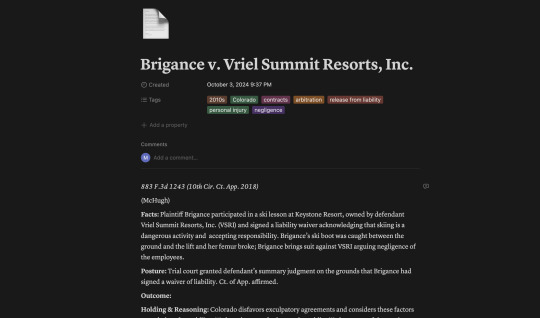
Please pardon the contract law screenshots lol. Notion lets me have a colorcoded system, open/close toggles for things we may only discuss briefly, and hyperlink to separate pages for (law school) each individual case. That in particular is amazing because on those case-pages I can include links, citations, and put searchable 'tags' for year, jurisdiction, keywords, etc. That means that as I go through law school, I'm actually building a searchable database of relevant case law on every topic I study. Brigance isn't a case with a media component, but if I was working on White v. Samsung or Leonard v. Pepsico, then I could include the relevant video and audio clips.
So notetaking on Notion is exactly what I want! But if you want to have a daily planner, or a journal, or a habit tracker, make sure you include that. YouTube is the best possible resource for finding something specific, but I occasionally find something neat on Instagram.
Tip #4: The most useful thing for me (and I really believe the most useful thing for any student who has syllabi) is an assignments database. This is really just Notion's basic Database: Table View that I've curated into a workhorse.
At the beginning of the semester, I look at all of my syllabi and put all of my readings, homework, exams, and special dates into a table, tagging each one with the class, type of assignment, and due date. Then I can use Notion's "Views" feature to sort them. I have a tab where I can see everything, a tab where I can see the next 2 weeks, a tab just for tests, a tab to sort by each class, and a 'catchup' tab that lists everything incomplete with a due date that's passed —by checking it off, it deletes itself from that "View" because it no longer fills all the criteria. (I have actually done the things shown here, I just wanted you to have something to look at).

Plus, I looove checking things off of the 'Full' tab and seeing that little % complete number at the bottom tick up!! This table means I'm never surprised by an assignment, exam, or event and preparation is more than half the battle. I've found that the best way to balance this really heavy-duty table on the opening page is to keep it on half the screen and fill the other side with gizmos and pictures. There's not a lot else you can do besides selecting the color of your tags.
Tip #5: Widgets! This is really where the fun aesthetic part comes in. Both Indify.co and Widgetbox.app work with Notion and it's how people include clocks, timers, weather reports, playlists, etc. They can be a bit of a humbug to install because they're hosted externally so to make adjustments you have to re-embed the new code into Notion; in particular, Spotify playlists take 10-20 minutes to update.
In general, I would still consider myself a Notion novice. There are some true wizards on YouTube doing things that frighten and impress my brain. If anyone has more resources, please add them below!
6 notes
·
View notes
Text
Boosting Productivity with Notion: Essential Tips for Software Developers
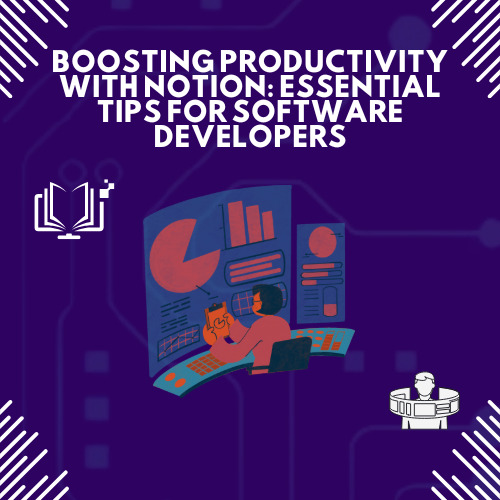
Notion is a powerful tool for organizing and boosting productivity. For software developers, it’s especially valuable, as it combines note-taking, project management, and collaboration features in one place. By setting up a dedicated workspace in Notion, developers can easily track tasks, store code snippets, and manage projects. This post will walk you through essential tips to make the most of Notion, helping you streamline your workflow and stay focused on coding.
Setting Up Your Workspace
Start by creating a central workspace in Notion for all your development needs. This workspace can be your main hub, where you keep project overviews, tasks, and quick links to important resources. Having everything in one place saves time and keeps you focused.
One helpful feature is Notion’s code blocks. You can use these to store code snippets, commands, or notes on syntax that you frequently need. By organizing snippets within your workspace, you can quickly reference them without searching through multiple files or tabs. Notion’s formatting options allow you to highlight code, making it both readable and easy to locate. Whether you’re working solo or with a team, having your snippets neatly stored in one place improves efficiency and reduces the chances of forgetting key code pieces.
For project tracking, set up a database to manage tasks, bugs, or new feature requests. You can customize fields such as task status, priority level, and due dates to match your development process. With Notion’s database, you can organize tasks into different views: list, table, or board, depending on your preference. The board view, for example, works well for Kanban-style project management, letting you drag tasks between columns like “To-Do,” “In Progress,” and “Completed.” This flexibility helps you stay organized, keep track of priorities, and adapt easily as your project evolves.
Project Management and Tracking Progress
Notion makes project management easy with its flexible organization tools. You can create task templates for different types of projects, saving time and ensuring consistency. Templates allow you to pre-fill fields like priority, due dates, or project stages, so every task stays organized from the start.
Using Kanban boards in Notion is a popular way to track progress. These boards let you visually move tasks through stages like "To-Do," "In Progress," and "Done." It’s simple to drag and drop tasks as they progress, giving you a clear view of what’s happening. This approach works well for sprint planning, daily task tracking, and even bug resolution.
For longer-term planning, Notion’s timeline and calendar views are great tools. You can schedule tasks by week or month, set milestones, and adjust dates as needed. These views help you track deadlines and keep everyone aligned on project timelines. Here are some common recommendations to help you get the most out of project management in Notion:
Use templates: Set up reusable templates for tasks and projects to save time.
Organize by priority: Add fields for priority levels to keep high-impact tasks front and center.
Combine views: Switch between Kanban, timeline, and calendar views for different project stages.
Set milestones: Mark key dates and project goals to track overall progress.
Assign tasks: Tag team members directly in tasks for clear accountability.
Enhancing Collaboration
Notion is a great tool for team collaboration. You can easily share pages, assign tasks, and tag team members in comments. This makes communication faster and more organized, with all discussions and updates in one place. Real-time editing allows everyone to work together on documents, reducing back-and-forth emails and keeping everyone aligned.
Integrating Notion with other tools also boosts teamwork. For example, syncing Notion with GitHub or Slack keeps projects updated across platforms, so team members stay informed. Additionally, creating a shared knowledge base in Notion helps everyone access important resources, documentation, and project details. This organized approach makes collaboration smoother, keeps everyone on the same page, and enhances productivity.
Boosting Personal Productivity
Notion can be a powerful tool for organizing your daily tasks. You can create to-do lists, set daily goals, and track progress all in one place. By having a clear outline of tasks each day, it’s easier to stay focused and prioritize what matters most. This setup helps keep you on track and reduces distractions.
Using Notion as a knowledge hub is also effective. You can store notes, tutorials, and helpful links in organized folders or databases. This way, you don’t have to search through endless bookmarks or files when you need information. Having all your resources in one place saves time and keeps learning materials easily accessible.
For long-term goals, Notion’s habit trackers and progress checklists can be helpful. You can set up goals for learning new skills, completing courses, or achieving specific project milestones. Tracking your progress regularly gives you a sense of accomplishment and keeps you motivated. With Notion’s customizable templates, you can easily adapt these tools to fit your personal productivity style.
Advanced Tips for Power Users
For those looking to take Notion to the next level, there are some powerful features to explore. The Notion API allows you to automate tasks and integrate with other tools. This is especially useful for developers who want to pull data from Notion or update entries automatically. With the API, you can streamline workflows and reduce manual work.
Embedding external content is another useful trick. You can embed Google Docs, Figma files, or other resources directly into Notion pages. This keeps all essential materials in one place, making it easy to access everything without switching between apps. Here are some more advanced tips to boost your productivity in Notion:
Use database relations: Link related databases to organize complex information.
Create rollups: Ssummarize information across linked databases for quick insights.
Automate with the API: Connect Notion with Zapier or custom scripts for automation.
Customize templates: Design templates for repetitive tasks, saving time on setup.
Set up custom shortcuts: Use keyboard shortcuts to navigate and edit quickly.
With these advanced tips, you can make Notion an even more powerful tool for managing projects, tracking tasks, and staying organized.
Summing Up
Notion offers a versatile, powerful platform for developers looking to streamline their workflow and boost productivity. By setting up an organized workspace, managing projects efficiently, and exploring advanced features, you can make Notion work for your unique needs. From tracking daily tasks to collaborating with your team, Notion keeps everything in one place, helping you stay focused and on top of your goals.
Whether you’re just starting or looking to maximize your Notion skills, these strategies can make a meaningful impact on your productivity. Embrace the flexibility and tools Notion provides, and tailor it to support your personal and professional growth.
2 notes
·
View notes
Text
here is a complete guide to my productivity model for notion! it is modeled after the app sunsama, but tailored to my personal needs :)
here is what the first page looks like:
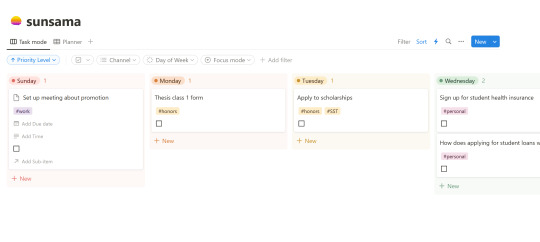
organized by day of the week, i can filter my tasks by priority level, channel, day of the week (to clear out the ones that are past!), or focus mode. (during a single study session, i will tag a few tasks "focus" so that i only see those on my to-do list.)
as you can see, i can edit the tile, or i can expand it to edit every available property. here's what that looks like:

here are what my channels and priority levels look like:

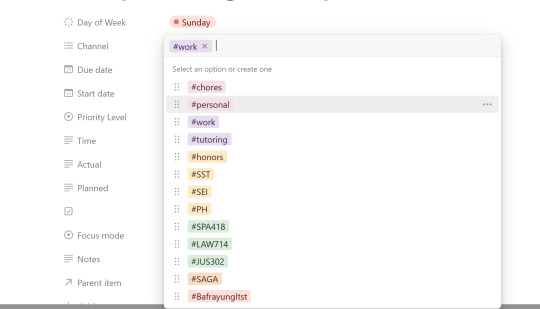
when i check a task off, it moves to my "finished" page, which is hidden in the main view:
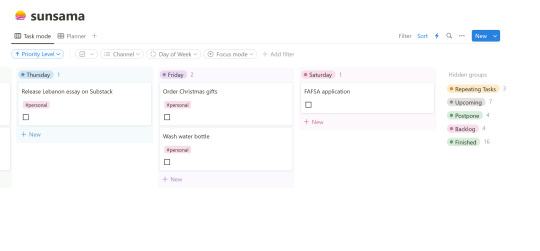
you can see i also have repeating tasks (mostly chores), upcoming tasks, postponed events, and a backlog of tasks that are easy to drag and drop between folders/days of the week. i clear out my finished tasks every week.
lastly, i add most of my tasks in "planning" mode, which looks like this:

that's just about it! personally i didn't need the timeblocking feature on notion because i don't organize my day that way (i have a very weak concept of time...), but the drag-and-drop kanban board was super important! it was not that difficult to set up and it was super fun to customize. let me know if anyone wants a template, the video i used to set up, or has any questions!
10 notes
·
View notes
Text
ObsidianMD Sales Pitch for tumblr users / creatives
its pretty much an excellent all-around jack of all trades tool. here's some samples of what you can do in it
Honestly, markdown is less complicated than it looks but in order to get around markdown just download a plugin called "Editing Toolbar" that recreates a Word-like environment. There's also the default hotkey command of Ctrl P that makes things easier.
You can embed Youtube Videos (aka all those tutorial videos) into your notes by default and use the "TimeStamp" community plugin to play, pause, and insert timestamps (doesnt have to be purple/pink, you can change the color)
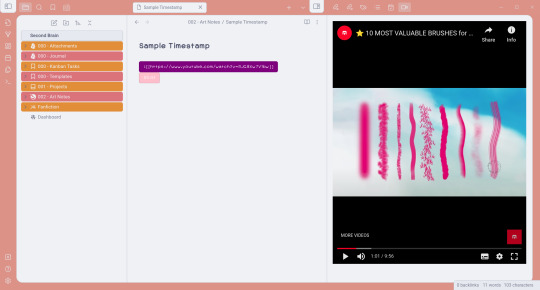
You can utilize the core plugin "Canva" to make mindmap and connections between notes. More importantly, you can hypothetically make relationship charts using arrows. There's also an excalidraw plugin---that one makes it look more hand-drawn.

There's a plugin called "Longform" for writers that combines "scenes" into one entire manuscript
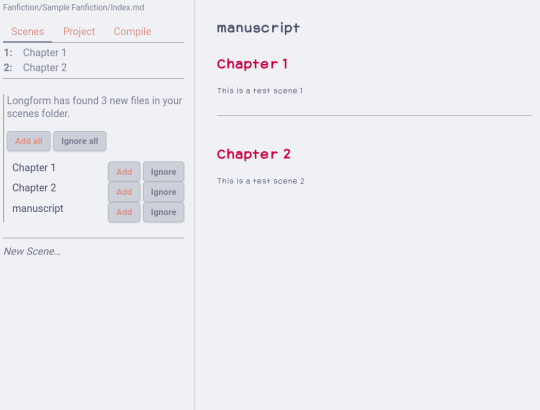
pdf integration is a thing! you can both export your notes as a pdf, and upload a pdf. this is a default ability of obsidian!
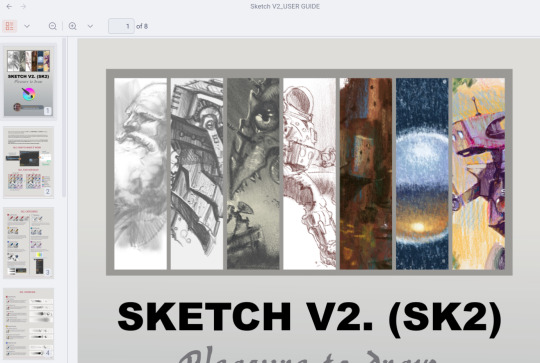
you can create templates to make note-taking super quicker
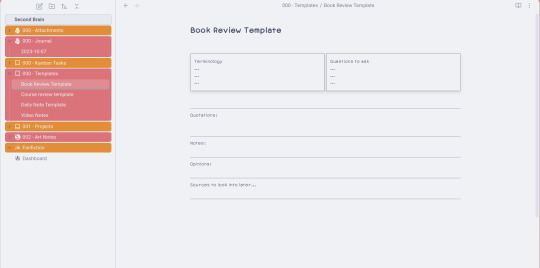
there's themes to make it look nicer and more aesthetic, and you can change the font! (I'm using Anuppucin with a etsy font I bought, if you're curious) (yes there's dark mode)
it runs very much on the concept of backlinks, which means if you create a link in one note, you can find out which notes all include that link. example of this with an embedded link
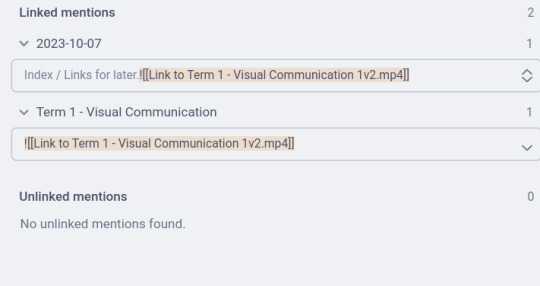
there's a kanban plugin!!!!

there's a kanban plugin!!!
in conclusion: obsidian is super cool, please try it out.
17 notes
·
View notes
Text
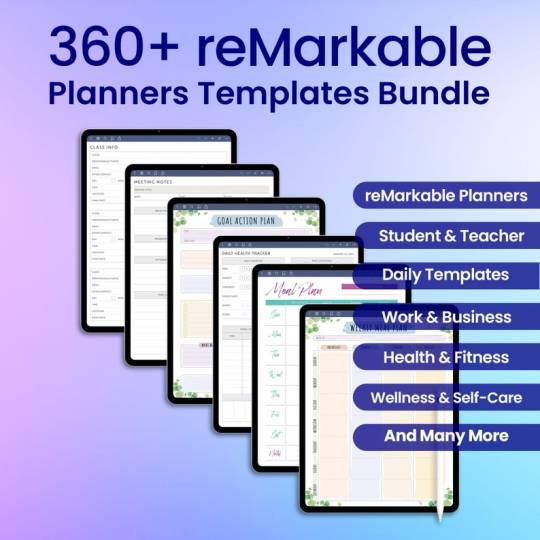
360+ reMarkable 2 Templates Bundle, reMarkable Templates, reMarkable 2 Planner Template, reMarkable Planners
✓ Index Page with navigation tabs, quick notes board, and reminders; ✓ 2024–2025 Calendars; ✓ Yearly Pages; ✓ Quarterly Planner; ✓ Quarterly Pages; ✓ Monthly Planner; ✓ Monthly Pages; ✓ Weekly Pages; ✓ Daily Pages; ✓ Goals & Productivity Section; ✓ Project Section; ✓ Customizable Project Sections; ✓ Finance Section; ✓ Others Section; ✓ Notes Layouts Section.
⭐reMarkable Daily Templates⭐
✓ Daily Schedule (Personal); ✓ Daily Schedule (Professional); ✓ Daily Schedule 15 min; ✓ Daily Schedule 24 h; ✓ Daily ADHD; ✓ Daily Gratitude; ✓ Daily To-Do List; ✓ Daily Meeting Notes; ✓ Reminders; ✓ Check List; ✓ Task List; ✓ Workflow & Checklist; ✓ Daily Chronodex; ✓ Daily Health Tracker Male / Female; ✓ Daily Wellness Journal; ✓ Daily Fitness Planner; ✓ Pomodoro Task Tracker; ✓ Ideas Inbox; ✓ Social Media Planner; ✓ Priority Matrix; ✓ Mind Map; ✓ Brain Dump; ✓ Daily Pain Tracker; ✓ 28 Notes Templates.
⭐reMarkable Weekly Templates⭐
✓ Weekly Horizontal; ✓ 2-Page Weekly Planner; ✓ Week at a Glance; ✓ Weekly Dashboard; ✓ Weekly Schedule 7-Days; ✓ Weekly Schedule 5-Days; ✓ 2-Page Weekly Schedule; ✓ Weekly with Priorities; ✓ Weekly Goals; ✓ Weekly Overview; ✓ Weekly Rhythm; ✓ Rolling Weekly; ✓ Weekly Budget; ✓ Income / Expense Tracker; ✓ Weekly Routine; ✓ Weekly Tracker; ✓ Weekly Wellness Chart; ✓ Self-Care Checklist; ✓ To-Do List; ✓ Priority Matrix; ✓ Task List; ✓ Checklist; ✓ Mind Map; ✓ Brain Dump; ✓ Reminders; ✓ Social Media Planner; ✓ Workflow & Checklist; ✓ 30 Notes Templates.
⭐reMarkable Monthly Templates⭐
✓ Monthly Planner; ✓ Monthly Planner with Notes; ✓ Monthly Summary; ✓ Month at a Glance; ✓ Monthly Goals; ✓ Monthly Overview; ✓ Monthly Review; ✓ Monthly Reading; ✓ To-Do List; ✓ Reminders; ✓ Checklist; ✓ Task List; ✓ Workflow & Checklist; ✓ Priority Matrix; ✓ 30 Notes Templates.
⭐reMarkable Quarterly Templates⭐
✓ Quarterly Planner; ✓ Quarterly Horizontal; ✓ Quarterly Dashboard; ✓ Quarterly Focus; ✓ Quarterly Goals; ✓ Quarterly Overview; ✓ Life Check-In; ✓ Reminders; ✓ Checklist; ✓ Task List; ✓ To-Do List; ✓ Priority Matrix; ✓ 29 Notes Templates.
⭐reMarkable Yearly Templates⭐
✓ Yearly Calendar; ✓ 2-Page Yearly Calender with Notes; ✓ Yearly Plan; ✓ Yearly Goals; ✓ Yearly Overview; ✓ Yearly Tracker; ✓ Yearly Review; ✓ Yearly Reading; ✓ Life Check-In; ✓ Reminders; ✓ Checklist; ✓ Task List; ✓ To-Do List; ✓ Priority Matrix; ✓ 30 Notes Templates.
⭐reMarkable GOALS Templates⭐
✓ Yearly Goals and Overview; ✓ Quarterly Goals and Overview; ✓ Monthly Goals and Overview; ✓ Wheel of Life; ✓ Level 10 Goals; ✓ Goals Overview; ✓ Professional Growth Plan; ✓ My Goal & Action Steps; ✓ Habit Trackers; ✓ SMART Goal; ✓ Goal Action Plan.
⭐ reMarkable PRODUCTIVITY Templates⭐
✓ Get Things Done (GTD); ✓ GTD Review; ✓ Ideas Inbox; ✓ Future Ideas; ✓ Current Tasks; ✓ Personal Tasks; ✓ Work Time Log; ✓ Pomodoro Planner; ✓ Pomodoro Task Tracker; ✓ Priority Matrix; ✓ To-Do with Priority; ✓ Time Tracker.
⭐ reMarkable PROJECT Templates⭐
✓ Project Plan; ✓ Project Notes; ✓ Timeline; ✓ Kanban Board; ✓ ToDos/Progress; ✓ Budget; ✓ Meeting Notes; ✓ Employee Schedule; ✓ Brain Dump.
⭐ reMarkable FINANCE Templates⭐
✓ Financial Yearly Overview; ✓ Yearly Bills; ✓ Monthly Budget; ✓ Savings Tracker; ✓ Visual Savings Tracker; ✓ 52 Week Savings; ✓ Visual Debt Tracker; ✓ Debt Snowball Tracker; ✓ No Spend Challenge; ✓ Sinking Funds Tracker; ✓ Monthly Household Budget.
⭐ reMarkable WORK & BUSINESS Templates⭐
✓ Workfow & Checklist; ✓ Task List; ✓ Mind Map ✓ Social Media Planner; ✓ Social Media Accounts; ✓ Social Media Stats.
⭐ reMarkable WELLNESS & SELF-CARE Templates⭐
✓ Self-Care Checklist; ✓ Travel Itinerary; ✓ About Me; ✓ My Vision; ✓ Wish List; ✓ Routines Tracker; ✓ Affirmation Prompts; ✓ My SWOT; ✓ Relaxation Techniques; ✓ My Happy Place.
⭐ reMarkable MEAL Templates⭐
✓ Weekly Meal Plan; ✓ Grocery List; ✓ Recipes.
⭐ reMarkable HEALTH & FITNESS Templates⭐
✓ Workout Tracker; ✓ Body Tracker; ✓ Running/Walking Tracker; ✓ Steps Plot Graph; ✓ Sleep Tracker.
⭐reMarkable OTHERS Templates⭐
✓ Reading List; ✓ Favorite Authors; ✓ Favorite Quotes; ✓ Contacts; ✓ Password log; ✓ Conference List; ✓ Conference Notes.
⭐ reMarkable NOTES PAGES Templates⭐
✓ Dot Grid; ✓ Ruled Grid; ✓ Square Grid; ✓ Sketchbook ✓ Ruled Grid Bottom ✓ Half Ruled with Grid ✓ Table 2-Column ✓ Cornell Rulled ✓ And other 22 note templates.
2 notes
·
View notes
Text
Notion is an all-in-one workspace designed to help individuals and teams organize their work and collaborate efficiently. It combines note-taking, project management, task management, and database capabilities into a single platform. Here is a detailed review of its features and functionalities:
Key Features
Workspace Customization:
Blocks and Pages: Notion’s modular approach allows users to create content using blocks, which can be text, images, tables, checklists, code snippets, and more. These blocks can be arranged on pages that act as the primary workspace.
Templates: Notion offers a variety of pre-built templates for different use cases such as meeting notes, project plans, to-do lists, and knowledge bases. Users can also create and share their own templates.
Note-Taking and Documentation:
Rich Text Editing: Notion supports rich text formatting, allowing users to create detailed and visually appealing documents.
Embedded Content: Users can embed various types of content, such as videos, audio files, and external web content, directly into their pages.
Database Integration: Notes and documents can be linked to databases, enabling dynamic content and relational data management.
Project and Task Management:
Kanban Boards: Notion offers Kanban-style boards for managing tasks and projects visually, providing an intuitive way to track progress.
Gantt Charts and Calendars: Users can create timelines and calendar views to manage deadlines and schedules.
Task Assignments and Reminders: Tasks can be assigned to team members, with due dates and reminders set to ensure timely completion.
Databases:
Relational Databases: Notion supports relational databases, allowing users to link different types of data and create complex workflows.
Views: Data can be viewed in multiple ways, including tables, lists, boards, calendars, and galleries, providing flexibility in how information is presented and accessed.
Filters and Sorting: Advanced filtering and sorting options help users manage and analyze data efficiently.
Collaboration:
Real-Time Collaboration: Multiple users can edit pages simultaneously, with changes reflected in real-time.
Comments and Mentions: Team members can leave comments, tag others, and start discussions directly within the content, facilitating communication.
Permissions and Sharing: Notion allows granular permission settings, enabling users to control access at the page, block, or workspace level.
Integration and API:
Third-Party Integrations: Notion integrates with various external tools such as Slack, Google Drive, and Trello, enhancing its functionality and connectivity.
API Access: The Notion API allows for custom integrations and automation, enabling users to extend the platform’s capabilities. Mobile and Desktop Apps:
Cross-Platform Access: Notion is available on iOS, Android, Windows, and macOS, ensuring users can access their work from any device.
Offline Access: The mobile and desktop apps support offline access, allowing users to work without an internet connection. Pros
Versatile and Flexible: Notion’s block-based system and customizable templates make it highly adaptable to various use cases, from simple note-taking to complex project management.
Unified Workspace: Combining notes, tasks, databases, and collaboration tools into one platform helps streamline workflows and reduce the need for multiple applications.
User-Friendly Interface: The intuitive and visually appealing interface makes it easy for users to navigate and create content.
Strong Collaboration Features: Real-time collaboration, comments, and mentions facilitate team communication and project coordination.
Cons Learning Curve: The extensive features and customization options may require time and effort for new users to fully grasp and utilize effectively.
Performance Issues: With large databases and extensive content, some users may experience performance slowdowns.
Limited Offline Functionality: While offline access is available, some features may be limited or not function as smoothly as they do online.
Complexity for Simple Tasks: For users with straightforward needs, the comprehensive feature set might feel overwhelming or unnecessarily complex.
Notion is a powerful and versatile tool that caters to a wide range of organizational and productivity needs. Its flexibility, comprehensive feature set, and strong collaboration capabilities make it a valuable resource for individuals and teams looking to streamline their workflows. However, the potential learning curve and performance considerations should be kept in mind. Overall, Notion provides significant value for those willing to invest the time to fully leverage its capabilities.
4 notes
·
View notes
Note
28 and 31 for the Ask Meme.

28. Any writing advice that works for you and you feel like sharing?
I have this post that has some writing advice: link
✿
Something that I have been using on and off lately with some of my long fics is a 'what's happened log,' just a short-worded entry on what happened in a chapter so you can go back if you need to check something you said for the future.
✿
Something that might help someone who feels like they have a pile of things to do but don't see the progress. I think it helps to have a Kanban board.
Here is a redacted version of my work for this month (ignore the numbers. I am on a writing streak at the moment)

You can do this with sticky notes, but if anyone is interested, I could probably add it to my free writing notion template. This works for things like schoolwork as well.
It's just nice when you have a massive pile of things to do to see it move to the done pile to keep you motivated.
✿
Write down that dumb thought you had. You don't have to use it. Just keep it, keep all the thoughts. They are all useful even just to tell you what you don't want to do.

31. What was the most difficult fic for you to write (but in the end, you made it)?
Difficult hmm.
I remember What He Left Behind giving me some trouble. I can't remember why, but I do remember wanting it to be over, which was unfortunate because people really liked it. I finished it and looking back, I like it, so I am not sure what it was that was giving me so much trouble.

This is in reference to this Fic Ask Game
3 notes
·
View notes
Text
Vabro - #1 Unified Platform to Streamline Your Workflows 🚀
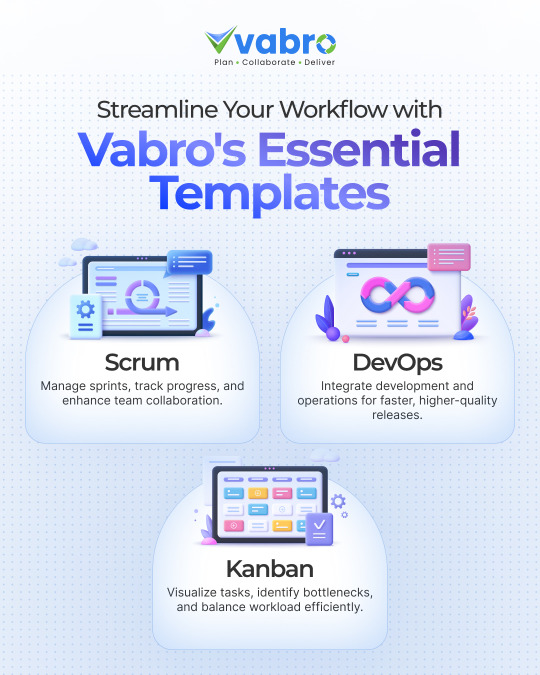
Tired of juggling multiple tools? Vabro's all-in-one platform seamlessly integrates Agile methodologies to meet your team's needs. Vabro's Essential Templates help you: 🔹 Manage sprints and boost collaboration with Scrum 🏃♂️ 🔹 Visualize tasks and optimize workload with Kanban 📊 🔹 Accelerate releases with DevOps 🚀 Say goodbye to siloed tools and hello to a unified platform. Vabro's customizable templates are a game-changer for teams of all sizes. Ready to transform your productivity? Please visit www.vabro.com today! 🔑
1 note
·
View note
Text
Top 10 Free Project Management Software in 2023
If there’s one area where free tools have revolutionized everything, it’s project management! It’s now much easier to work as a team and properly structure the stages of a project thanks to several solutions you discover in this article.
Depending on your needs and your type of operation, one or the other of these tools will be useful for your projects, so that I will summarize these strengths and weaknesses for each one. Finally, find your ideal project management software in this selection!
1. Projektly.com
Are you seeking a powerful, efficient, intuitive project management and teamwork tool? Projektly.com is the ideal online software because it has many functions, such as managing tasks (prioritizing, assigning to team members) and setting goals and deadlines to ensure good productivity.
You control everything in one place by following the progress of projects in real-time. You can store files directly in the collaborative workspace and connect thousands of other tools to accelerate projects.
Without a doubt, the project management software most often meets the needs of companies of all sizes. Planning a project and carrying it out while maintaining good time management is the objective that will be achieved thanks to this solution. The tool offers a free trial without obligation for 30 days.
2. Hubspot
Hubspot offers easy-to-use project management software that’s known for being very powerful. With this software, you can create and manage different team tasks (including deadlines, recurrences, or adding documents to your tasks), manage the execution of your projects entirely (thanks to integrating other Hubspot marketing tools), and create project templates that you can reuse later.
With Hubspot, you’re guaranteed to use a complete and intuitive tool that will meet your expectations to save time and increase productivity.
3. Teamwork
Managing projects with different teams or even with people outside your organization can be complex. This is where the Teamwork software comes into play. You work with several people or groups with specialized skills to achieve your goals. Teamwork can make it easy if you’re working with employees, freelancers, or external partners to achieve an end goal.
Teamwork helps project managers keep track of all their tasks, documents, discussions, contacts, etc. It gives you a clear view of the work done on a particular project or task, wherever you are. You can search for files or conversations on your computer or through mobile apps by keyword (to make it easier to find). With Teamwork Calendar, you can easily plan projects while collaborating with others and managing multiple projects at once.
4. Favro, the rising project management software
Favro is a project management and collaboration tool for employees to plan, follow, and develop ideas. Designed to adapt to the size and needs of any project, Favro allows users to add functions and integrations according to their requirements. Favro offers team dashboards, aggregated reports, and built-in Kanban and SCRUM functions support.
Projects are divided into different tasks, making it possible to follow each job individually. The solution has a scheduling board where employees can list their tasks and update other team members on the status of the tasks.
Favro, like Trello, is a project management software based on Kanban. The main difference is that Favro has more features than Trello and more integrations with third-party applications and possible automation. 5. Wrike
Wrike aims to save you time and allow all team members to focus on their core responsibilities. Whether tracking and organizing tasks, managing calendars, or communicating through discussion forums, Wrike can help you optimize your workflow and complete projects faster. With Wrike, you can collaborate in real time, and this tool offers many valuable features, such as reports and dashboards for quick data analysis to track project progress. You can also manage work schedules for each team member, Gantt charts to visualize progress over time, multi-level security controls, file downloads, and more.
6. Trello
The best-known free management tool, Trello, is one of the essential ones. The concept of project management takes the form of “cards” that contain lists of actions that you can move in a table that you have structured with columns according to your needs. For example, you can create a column for urgent and essential actions, another for urgent and unimportant, etc. This logic follows the Kanban project management procedure (the one Toyota used).
7. Nutcache
Nutcache falls into the category of all-in-one solutions. In addition to collaborative project management, Nutcache offers teams of all sizes complete management software, including project budgets, assignment tasks, time tracking, expense management, and final billing. With this software, there is no need for management training. Nutcache is free for teams of up to 20 members, which may allow you to do a free trial before moving to the paid plan if necessary.
8. FreedCamp
For those familiar with the BaseCamp management tool they won’t be out of tune with FreedCamp, which includes its main functionalities, but with the advantage of being freemium. The idea here is to manage team projects with several functionalities such as task assignment, the possibility of commenting, a calendar view of actions to be performed, document management, etc. The tool is well thought out if you have several projects in parallel with several teams.
9. Zoho Projects
Zoho Projects is, as its name suggests, part of Zoho’s suite of professional tools (CRM, Docs, Mail, etc.). Among the notable advantages of the solution, the control panels on the progress of tasks and the integrated time tracking system are potentially very interesting for agencies in particular. We can also highlight the integration with other Zoho solutions and with Google Docs or Dropbox.
10. Wimi
Wimi is a French freemium project management software created in 2010. The interface is very user-friendly, with a Kanban-shaped presentation. Wimi offers several potentially useful professional tools, such as discussion channels, video/audio calls, collaborative platforms, etc. Remember that Wimi provides a free webinar to help you understand its different functions and efficiently manage and plan your projects. This is perfect for customizable project tracking.
3 notes
·
View notes
Text
How to Use Project Management Tools Like Asana or Trello for PPC Workflow
Efficient project management is essential for delivering successful PPC services. Whether you’re managing multiple campaigns or working with a growing team, tools like Asana and Trello can streamline your workflow and ensure timely execution of tasks. As a leading provider of PPC services in Pune, Digital Rhetoric leverages these tools to enhance productivity, improve collaboration, and maintain transparency in campaign management.
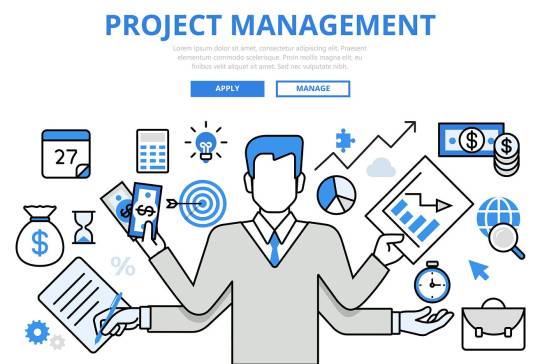
1. Why Project Management Tools Matter for PPC Services
Managing a PPC campaign involves multiple tasks — keyword research, ad creation, campaign optimization, performance tracking, and reporting. Without a structured workflow, it’s easy to miss deadlines or lose track of important details.
Project management tools help by:
Organizing tasks in a central place.
Improving collaboration among team members.
Providing real-time updates on project progress.
Reducing errors and ensuring consistency.
2. Overview of Asana and Trello
Asana
Asana is a powerful project management tool that offers task lists, boards, timelines, and automation features. It’s ideal for managing complex workflows and multiple campaigns.
Key Features of Asana:
Task prioritization and deadlines
Custom workflows and templates
Timeline and calendar views
Integration with Google Drive, Slack, and more
Trello
Trello is a visual project management tool based on Kanban boards. It’s perfect for teams looking for a simple yet effective way to manage tasks.
Key Features of Trello:
Drag-and-drop task management
Customizable boards and lists
Labels and due dates for task organization
Integration with tools like Zapier and Slack
3. Setting Up Your PPC Workflow in Asana
To use Asana for your PPC services, start by creating a dedicated project for each client or campaign.
Step-by-Step Process:
Create a New Project: Use a template or start from scratch.
Define Key Stages: Break down your PPC workflow into key stages — Research, Setup, Optimization, Reporting.
Assign Tasks: Create tasks for each stage and assign them to the appropriate team members.
Keyword Research
Campaign Setup
Ad Copy Creation
Performance Monitoring
Monthly Reporting
Set Deadlines: Ensure each task has a clear due date to maintain accountability.
Track Progress: Use the Timeline or Calendar view to monitor task completion.
Example Workflow in Asana:
Campaign Research: Assigned to PPC Executive — Due in 2 days
Ad Copy Approval: Assigned to Content Team — Due in 3 days
Performance Review: Assigned to PPC Manager — Due every Friday
4. Using Trello for PPC Workflow Management
Trello offers a more visual approach to workflow management, making it easy to track tasks at a glance.
How to Set Up Your PPC Workflow in Trello:
Create a Board: Name your board based on the campaign or client.
Set Up Lists: Create lists for each stage of the PPC workflow — To Do, In Progress, Completed.
Add Cards: Each task becomes a card that you can move between lists.
Assign Members and Deadlines: Add team members to cards and set due dates for each task.
Use Labels: Use color-coded labels to categorize tasks (e.g., Research, Optimization, Reporting).
Example Trello Board Setup:
List 1: To Do
Research competitor ads
Prepare ad creatives
List 2: In Progress
Set up Google Ads campaign
Launch Facebook Ads
List 3: Completed
Keyword research
Audience targeting setup
5. Tips for Maximizing Efficiency with Asana and Trello
To get the most out of these tools, follow these best practices:
1. Standardize Your Workflow
Create templates for recurring tasks like campaign setup or monthly reporting to save time.
2. Use Automation
In Asana, automate task assignments or reminders for recurring activities like weekly performance reviews. Trello offers Power-Ups for automation.
3. Integrate with Other Tools
Both Asana and Trello integrate with Slack, Google Drive, and other tools to improve collaboration and file sharing.
4. Monitor and Adjust
Regularly review your workflow to identify bottlenecks and improve efficiency.
6. Collaboration and Transparency
One of the biggest advantages of project management tools is improved collaboration. These tools offer a transparent view of the project’s progress, ensuring that everyone is on the same page.
Team Updates: Share real-time updates with team members.
Centralized Communication: Keep all communication related to a project within the tool.
Improved Accountability: Assign specific tasks to team members to ensure clear responsibility.
Conclusion
Project management tools like Asana and Trello can revolutionize your PPC services workflow by bringing structure, improving collaboration, and ensuring timely delivery. Whether you prefer the robust features of Asana or the simplicity of Trello, integrating these tools into your daily operations will help you manage multiple campaigns efficiently.
If you’re a business looking for expert PPC services in Pune, Digital Rhetoric is here to help. Contact us today to learn how we can manage your PPC campaigns with precision and expertise.
0 notes
Text
Beginner’s Blueprint to Azure DevOps Training and Success
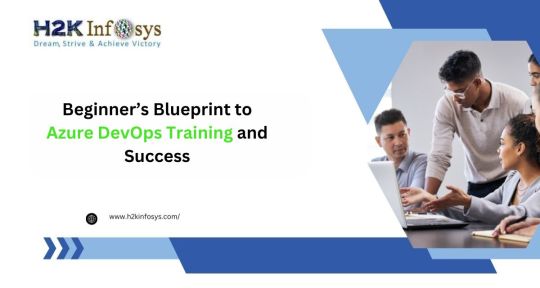
Introduction: Why Azure DevOps is Your Key to Success
In today’s fast-paced tech world, DevOps has become an indispensable approach to streamlining software development and IT operations. Microsoft’s Azure DevOps stands out as a leader, offering tools that enhance collaboration, automate workflows, and drive innovation. If you’re a beginner aiming to break into the DevOps landscape, enrolling in an Azure DevOps training course can be your stepping stone to a successful career.
In this blog, we will cover everything you need to know about Azure DevOps training, its real-world applications, and how it can set you apart in the competitive IT industry. Let’s dive in.
What is Azure DevOps?
Azure DevOps is a cloud-based platform by Microsoft designed to provide end-to-end DevOps capabilities. It integrates development (Dev) and operations (Ops) into a seamless system to help teams deliver software faster and with higher quality. Key components include:
Azure Boards: For project management and tracking work.
Azure Repos: Git repositories for version control.
Azure Pipelines: CI/CD pipelines for automating builds and deployments.
Azure Test Plans: Tools for testing and quality assurance.
Azure Artifacts: Package management and artifact sharing.
Why Learn Azure DevOps?
High Demand in the Job Market: Companies globally are adopting DevOps practices, creating a surge in demand for Azure DevOps experts.
Industry Recognition: Azure DevOps certification enhances your resume and credibility.
Improved Collaboration: Learn how to bridge the gap between development and operations teams.
Automated Workflows: Master the automation of complex tasks, reducing errors and saving time.
Future-Proof Skills: Azure DevOps proficiency prepares you for modern software development trends.
Azure DevOps Certification: A Game-Changer for Your Career
What is Azure DevOps Certification?
Azure DevOps certifications validate your expertise in implementing DevOps practices using Azure tools. Key certifications include:
Microsoft Certified: DevOps Engineer Expert
Microsoft Certified: Azure Fundamentals
Benefits of Getting Certified
Career Advancement: Stand out in a competitive job market.
Higher Salary: Certified professionals often earn 20-30% more than their uncertified peers.
Global Recognition: Microsoft certifications are respected worldwide.
Hands-On Learning: Gain practical skills that are immediately applicable.
Key Features of Azure DevOps Training
A comprehensive Azure DevOps course should include the following:
1. Introduction to DevOps Principles
Understanding DevOps culture and its importance.
Key methodologies like Agile, Scrum, and Kanban.
2. Azure DevOps Tools
Hands-on training with Azure Boards, Repos, Pipelines, Test Plans, and Artifacts.
Setting up CI/CD pipelines for real-world projects.
3. Version Control with Azure Repos
Working with Git for source control.
Branching, merging, and pull requests.
4. Infrastructure as Code (IaC)
Using ARM Templates and Terraform for automated infrastructure.
5. Monitoring and Feedback
Setting up automated monitoring using Azure Monitor and Application Insights.
6. Real-World Projects
Building and deploying applications to Azure.
Troubleshooting common issues in DevOps pipelines.
Learning Path: Step-by-Step Guide
Step 1: Understand the Basics
Start with the fundamentals of DevOps, focusing on its cultural and technical aspects.
Step 2: Enroll in an Azure DevOps Course
Choose a course that offers hands-on projects, real-world scenarios, and expert guidance. H2K Infosys provides an industry-aligned Azure DevOps training online to help you master these skills.
Step 3: Practice Hands-On
Set up your own Azure DevOps environment. Practice building pipelines, managing repositories, and deploying applications.
Step 4: Earn Certification
Prepare for and pass the Azure DevOps certification exam to validate your skills.
Step 5: Apply Your Skills
Work on real-world projects or internships to solidify your learning and gain practical experience.
Real-World Applications of Azure DevOps
Streamlined Software Delivery: Automate your build, test, and deployment processes for faster releases.
Enhanced Collaboration: Integrate development and operations teams using Azure Boards.
Scalable Infrastructure: Deploy and manage scalable cloud environments with IaC tools.
Continuous Monitoring: Ensure application reliability with automated monitoring and feedback.
Why Choose H2K Infosys for Azure DevOps Training?
Expert Instructors: Learn from industry professionals with years of experience.
Practical Focus: Hands-on projects and real-world scenarios.
Flexible Learning: Online classes tailored to fit your schedule.
Career Support: Resume building, interview prep, and job placement assistance.
Key Takeaways
Azure DevOps is a powerful platform for modern DevOps practices.
Certification boosts your career prospects and earning potential.
A structured learning path and hands-on experience are essential for success.
Conclusion: Take the First Step Toward Your DevOps Career
Ready to kickstart your journey into the world of Azure DevOps? Enroll in H2K Infosys’ Azure DevOps training online today. Gain hands-on skills, earn your certification, and accelerate your career in DevOps. Let’s build your future together!
#devops engineer#devops engineer course#devops engineer certification#azure devops git training#devops training#azure devops training#devops and aws training#devops with aws training#devops training online#devops certification training#devops online training#devops training and certification#azure devops certification#azure devops course#best devops training online free#learn azure devops#devops certification microsoft#devops microsoft certification#azure devops training online#aws devops training online
0 notes